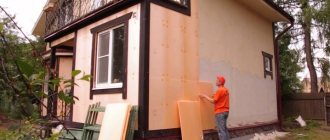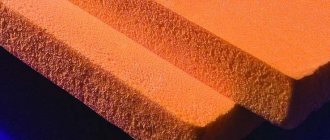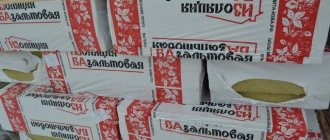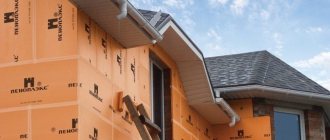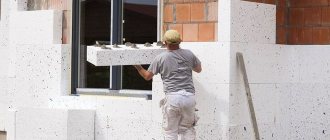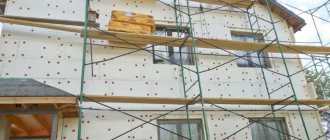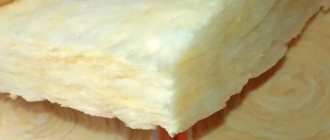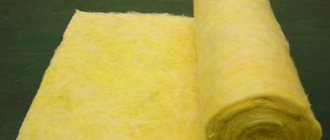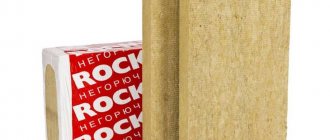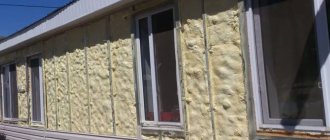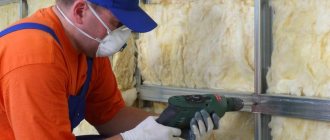Many are afraid to use penoplex, believing that it is unsafe, but this is a controversial statement. The material is only dangerous in case of fire, as it emits harmful substances, but this can also be avoided. Let's learn about the features of this insulation, its advantages and disadvantages, its features and how to use it correctly and where. We will determine whether penoplex indoors is harmful to health, whether it can be used in residential buildings, and whether there are any restrictions.
Appearance Source sps2016.ru
What is it and where is penoplex used?
Penoplex (“Penoplex”) is a large company that produces construction and finishing materials. The company also produces extruded (melted in a high-pressure oven) expanded polystyrene (EPS, XRS) or penoplex. This is a thermal insulation material that has excellent thermal characteristics. A sheet of material just 2 cm thick retains as much heat as a 20 cm thick wooden wall, 27 cm thick foam concrete or 37 cm thick brick wall.
Compared to foamed polystyrene (foam), penoplex has a higher density, so it better withstands mechanical loads. The material has low moisture permeability and almost does not conduct steam.
Penoplex is used when resistance to stress and low vapor permeability are important. It is used:
- For insulation of floors, facades, internal walls, non-residential basements;
- On flat roofs;
- For insulation of wells and septic tanks;
- On paths and playgrounds.
Using penoplex Source prom.st
The company produces several brands of material that differ in properties. For example, for insulation of foundations and underground garages, frost-resistant “Penoplex Comfort” or “Foundation” is used (it can withstand heavy loads), for insulation of balconies and external walls - “Wall” with low thermal conductivity, for roofs - non-flammable “Roof”.
At the same time, it is important to establish a ventilation system, which, like penoplex, does not allow steam to pass through. In the home, this can lead to increased humidity and the need for artificial regulation. However, this is not always necessary: for example, when insulating the floor, ventilation is not needed.
See also: Catalog of companies that specialize in finishing materials and related work
What thickness is needed - calculation of parameters
To calculate the minimum required thickness of penoplex for foundation insulation, you must use the formula:
R=h1/λ1+h2/ λ2 , where
- R – heat transfer resistance ((m2*°С)/W for a certain region according to SNiP 23-01-99;
- h1 – base thickness (m);
- λ1 – thermal conductivity of the foundation (W/(m*°С));
- h2 – insulation thickness (m);
- λ2 – thermal conductivity of penoplex (W/(m*°С)).
Let's take for example the value R=3.23 (the norm for St. Petersburg), h1=0.4, λ1=1.69, and λ2=0.032.
As a result, we get the following formula:
- 3.23=0.4/1.69+h2/0.032;
- 3.23=0.24+h2/0.032;
- h2=2.99*0.032;
- h2=0.09568, which is approximately equal to 95 mm, but if you take it with a margin, then slabs 100 mm thick will do.
To calculate the approximate number of slabs that are needed to insulate the foundation, let’s take a 10x8 house (approximate perimeter 10*2+8*2) and a base height of 1 m. This gives a coverage area of 36 m2. If you take a standard slab with a surface area of 0.72 m2, then for insulation you will need about 50 pieces.
Advantages and disadvantages
It is worth finding out whether penoplex is harmful to health. Like any material, it has a number of pros and cons. To understand whether it is harmful to health, it is worth learning a little more about insulation.
The advantages of the material include:
- Long service life: penoplex can be used for up to 50 years;
- Tolerates low (up to -50 degrees) and high (up to +75 degrees) temperatures;
- Does not absorb water, does not require additional waterproofing;
Penoplex close up Source sladkiyson.net
- Does not react with most chemicals. The material is destroyed only upon contact with a solvent;
- Withstands mechanical loads without breaking. On average, penoplex can withstand pressure of up to 4 kg per square centimeter, some brands (for example, “Foundation”) - up to 27 kg. Polystyrene foam can withstand no more than 0.5 kg per square centimeter.
In addition, the material is easy to use. It does not require additional processing or special skills; it can be cut with a knife and glued with glue or special foam.
Penoplex has some disadvantages:
- It is easily destroyed when exposed to direct sunlight. When working with it, it is better to choose a cloudy day and do everything quickly;
- It is easy for mice to breed in it;
- Its cost is higher than that of other insulation materials;
- Penoplex is flammable. It belongs to categories G3 and G4, which include the most flammable materials.
In advertising they often say that the material does not burn and is safer than wood. This is not so: you can determine whether penoplex is harmful by its flammability. The material is highly flammable and emits vapors that are hazardous to health. You can reduce the harm by treating the sheets with fire retardant compounds. This will help reduce flammability to class G1. In the event of a fire, the penoplex will melt and will not be able to support the fire.
Comparison of materials by main characteristics
Many buyers, when assessing whether it is better to use polystyrene foam or polystyrene foam for insulation, also look at the cost of building materials. It is important that the first one, on average, costs about 1.5 times less than its competitor. The price of raw materials can play a decisive role in the choice of material, especially if the buyer's budget is limited. It is for this reason that the first option is more popular among developers, since its low cost allows the cost of housing to be reduced.
It should be noted that polystyrene foam retains heat worse than its alternative, since it is less dense due to the high air content in the composition. Compressed and solid penoplex copes much better with the task of maintaining temperature. So, for a similar thermal conductivity, a quarter more foam is needed than the second material described.
Also important is the fact that penoplex is more moisture resistant than polystyrene foam. Due to its lower density than its competitor, a small amount of moisture can penetrate into the pores between the foam granules in some situations. Due to the more integral and dense structure, this does not happen with penoplex. The moisture absorption rate of polystyrene foam is approximately 2%, while its alternative is less than 0.5%. In general, both materials are highly resistant to direct exposure to steam, but penoplex is still slightly better than its competitor in this indicator.
Requirements for insulation
Insulation is an important material in construction that can affect the health and safety of occupants. You shouldn't choose based on price alone.
When choosing insulation, it is important to pay attention to the following points:
- The material should not contain fine fibers or dust;
- It should not contain harmful phenol-formaldehyde resins;
- During operation, it does not emit harmful substances even at high temperatures;
- It practically does not get wet, since fungi and mold easily grow in wet material.
According to these criteria, penoplex is absolutely safe. It has the necessary certificates of conformity, has passed all tests and is found safe when used correctly.
Balcony insulation Source remontnik.ru
Myths about insulation
Reviews of penoplex are varied, and there are many questions about whether polystyrene foam is harmful as insulation indoors. Some believe that extruded polystyrene foam is harmful and should not be used in the home, others note that the material is completely safe.
The most popular myths include the following:
- Penoplex emits harmful fumes. This is not true: when processing sheets, the material becomes greatly compacted and generally stops releasing vapor into the air. In addition, the sheets are covered on the outside with a finish that will not let harmful substances through, even if they are present.
- The insulation does not allow steam to pass through, which is harmful for residents and the material itself. The walls should not allow moisture or steam to pass through, as the room will become damp. To prevent the insulation itself from getting wet, it is enough to provide good ventilation.
- The presence of penoplex increases the risk of fire. This is a controversial statement. The insulation itself will not catch fire, but during a fire it easily flares up and releases hazardous substances. The sheets must be additionally treated with fire retardant compounds so that they do not burn, but melt.
Warming of surfaces
Both polystyrene foam and polystyrene foam are equally suitable for insulating floors and ceilings. The process of insulating the ceiling occurs as follows:
- Cleaning the ceiling down to the concrete surface;
- Treating the surface with a primer, and if it is strongly absorbed, then it needs to be treated several times. This stage is necessary to protect the ceiling from bacteria and fungi.
- The blocks are glued with a special glue, which is applied either directly to the ceiling or to the material. There is no fundamental difference here. After applying the adhesive, the polystyrene foam panel is applied to the ceiling and held until the adhesive begins to set. Then they are additionally secured with dowels. The principle is the same as for walls - five pieces per surface.
- When the entire ceiling is covered with polystyrene foam, a reinforcing layer is applied and a reinforcing mesh is added. This is necessary to improve waterproof qualities and elasticity. Because of the mesh, polystyrene foam cannot be broken. But the main thing is that the flammability of the material decreases.
- When the surface hardens, finishing work is carried out, joints are puttied, wallpaper is glued, and the ceiling is painted.
Floor insulation
Extruded polystyrene foam is suitable for all types of floor insulation, that is, on the ground, under a wooden floor, for concrete screed. It is better not to use polystyrene foam for these purposes at all. You can, of course, lay it down and secure it, but as a material it is quite fragile, especially under constant loads. Therefore, it is preferable to use extruded polystyrene foam.
Laying extruded polystyrene foam on the ground.
Initially, a 10 cm thick embankment is made of gravel or slag, the voids are then filled with expanded clay. If there is no basement, then for insulation you should choose the thickest material. Then logs are fixed on top - these are wooden beams several meters long that serve as support for the floor. They are installed so that the distance between them is 40-50 cm. All remaining free space is sealed with penoplex. Important! The top of the material should be covered with a waterproofing mixture, paying special attention to the joints.
For wooden floor
The technology is the same, only a cement screed is made on top of the logs, insulated with extruded polystyrene foam. Wooden floors, laminate, linoleum and so on are laid on it.
Concrete floor
If you have a ready-made concrete floor that needs to be insulated, then do the following:
Checking how smooth the surface is. If the differences are no more than 2-4 mm, then the foam boards can be laid without additional supports, such as the same logs. If there are more unevennesses, then there are two options - to level the floor, or to nail down joists and lay polystyrene foam between them.
The floor insulation also needs to be strengthened with a reinforcing mesh and a layer of waterproofing. Then, usually, the floor is finished.
Video description
You can learn about the fire hazard of penoplex from the video:
- There are a lot of negative reviews from those who are already using the material. There are few negative reviews; they are in no way directly related to harmful effects. There are much more positive reviews: buyers note that they were not disappointed in the penoplex and did not notice any shortcomings.
Thus, it is not difficult to decide whether polystyrene foam as indoor insulation is harmful to health.
It is important to remember that only products from well-known manufacturers are safe. It has passed the appropriate tests and can be used in residential buildings. It is also important to remember that the technical characteristics of penoplex are maintained only with proper installation and operation. Although there are very few situations in which these conditions can be violated.
Briefly about the main thing
Penoplex is a new material for insulation. Its main differences are strength, durability, resistance to various temperatures and exposure to water.
The main disadvantages of insulation are its high price, the likelihood of mice appearing inside it, and high flammability. Penoplex belongs to the flammability groups G3 and G4.
Despite the large number of myths, penoplex is safe and does not harm humans in any way during operation. Only products from well-known manufacturers that have passed the necessary tests and received certificates are distinguished by high quality.
In case of fire, sheets can release harmful substances. To prevent this from happening, it is necessary to treat them with special solutions.
